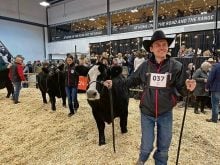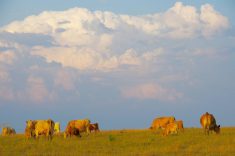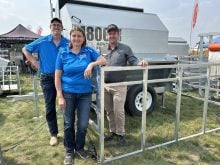Residual feed intake (RFI) as a measure of feed efficiency has been around since 1957, but its use was limited to the back barns of research because animals had to be meticulously penned and fed separately to monitor intake. Electronic tags for animal identification coupled with leaps in computer technology and wireless transmission of electronic data have changed all that since the early 2000s.
Researchers in Alberta were leaders in applying RFI at the commercial level and GrowSafe Systems of Airdrie, Alta., had developed the technology to do it by electronically capturing the weight of feed consumed by individual animals in group settings.
Read Also

What to know before you go to Agribition 2025
If you’re attending Agribition 2025, this is the place to find out about tickets, dates and what’s happening this year.
RFI is the difference between an animal’s actual feed consumption and the calculated prediction of how much an animal of its size would need to eat for maintenance and growth at a targeted rate during a test period of at least 70 days. Animals that eat less than predicted are more feed efficient than those that eat more than predicted.
The average for each test is zero and the RFI is given as the weight of dry-matter intake per day. An RFI of -1.0, for example, means that an animal ate 1.0 pound of dry matter per day less than predicted for its size and growth, whereas an animal in the same test group with an RFI of +1.0 is less feed efficient because it had to eat 1.0 pound per day more than predicted for the same output.
RFI is moderately inheritable and genetically unrelated to body weight and average daily gain. This is apparent because animals that gain at the same rate and have similar body weights at the end of a test can have very different RFIs.
Research on use of RFI as a true measure of feed efficiency at the commercial level began in Australia not long before Dr. John Basarab with Alberta Agriculture started investigating its potential with the installation of GrowSafe pens at the Lacombe Research and Development Centre in 1999 and Olds College in 2002.
Research from Canada, Australia and the U.S. supports a high level of confidence that selecting for low-RFI bulls and females reduces feed intake by up to 12 per cent and improves feed conversion ratios by up to 15 per cent without affecting growth rate, mature body size or carcass quality.
The latest Alberta research is digging deeper into the environmental benefits of selecting low-RFI cattle after early trials showed the potential to reduce feed energy wasted as heat production by approximately 10 per cent, methane emissions from digestion by up to 12 per cent, and manure nitrogen, phosphorus and potassium levels by 15 to 17 per cent.
Given that single-trait selection can have adverse effects on other traits, one lingering question is whether selecting low-RFI bulls and replacement heifers will negatively influence cow productivity in the long run.
Dr. Paul Arthur’s group in Australia and Basarab’s team in Alberta have noticed that lower-RFI heifers reach puberty five to six days later on average and are slightly less likely to reach puberty by 11 months of age.
Western Beef Development Centre
Researchers at the WBDC near Lanigan, Sask., had similar results with low-RFI heifers.
Their trial followed heifers from weaning in 2012 through to weaning of their first calves in 2014. Ninety heifers from the WBDC herd took part in the trial. The control group of 20 heifers was selected by the ranch manager based on the calves’ performance and conformation as well as dam and sire records. The remaining 70 were tested and sorted into a low-RFI group, the 20 most feed-efficient (average -2.2) heifers and a high-RFI group, the 20 least feed-efficient (average +1.7). The rest left the trial.
All 60 heifers in the three remaining groups were managed the same on forage-based rations through the winter in two dry-lot pens with GrowSafe feeders.
The low-RFI heifers ate three per cent less than the control heifers and 10 per cent less than high-RFI heifers to achieve similar rates of gain, improving the feed-to-gain ratio by five per cent over the control group and 11 per cent over the high-RFI heifers.
The economic analysis shows that daily feed costs from weaning to breeding were $1.38 for the low-RFI heifers, $1.43 for the control heifers, and $1.52 for the high-RFI heifers
Otherwise, the heifers at this point were essentially equal in terms of average daily gain, body condition score, weight (average 61.4 per cent of mature body weight) and age at breeding (average 14.3 months). Estrus was synchronized with a single injection of estroPLAN given five days after bulls were turned out at a ratio of one bull per 20 heifers.
By October, however, only 16 of the low-RFI heifers were pregnant compared to all 20 of the high-RFI heifers and 19 of the control heifers.
Not quite half of the low-RFI heifers calved in the first 21 days compared with 90 per cent of the control heifers and 72 per cent of the high-RFI heifers.
Calf birth weights and 205-day adjusted weaning weights were 71 lbs. and 531 lbs., respectively, for the low-RFI heifers, 71 lbs. and 565 lbs. for the control heifers, and 77 lbs. and 567 lbs. for the high-RFI heifers.
WBDC research scientist Dr. Bart Lardner admits the small sample size in this trial could have been a factor, but that the study does red-flag the need for further investigation with larger groups to evaluate this potential risk.
He reminds producers that there is no feed-efficiency silver bullet and this couldn’t be more true for cattle because of the intricate digestive system with its rumen and rumen bugs. The composition of the diet and its digestibility will have an effect on feed efficiency, and past studies have shown that many animals re-rank (low, medium, high) for RFI depending on the type of diet (grain, forage) and feeding system (drylot, winter grazing, summer pasture).
A related study found that the RFI ranking changed for 51 per cent of heifers, even when fed the same diet in two separate trials: when they were six months old and 10 months old.
Another aspect of the RFI work found low correlation between RFI values from the trial and RFI values for the same animals from DNA analysis with the Igenity marker panel. Accuracy of marker panels really depends on the population used for validation and very few of the validation trials are done in Western Canada’s environmental conditions and with breeds commonly found in herds here, Lardner explains.
So, as of yet, there isn’t a practical, affordable way to track genetic progress in feed efficiency at the ranch level.
His message to producers is that while there are lots of good reasons for selecting feed-efficient animals, it’s important to keep an open mind, think about your objectives for building your herd and use RFI in tandem with other traits.
WBDC’s beef economist, Kathy Larson, was interested to see how well the control group selected by the ranch manager measured up in terms of performance and feed costs. It indicates the importance of knowing your herd, measuring what can be easily measured, such as birth weights and weaning weights, and keeping records to help make decisions on replacement heifers.
Even though the $24 per head savings in feed cost for the low-RFI heifers during the 185-day development period may not seem like a lot, every little bit helps considering the huge cost to develop breeding heifers. The cost of feed and labour is second only to the lost income by not selling the heifers, or the cost of purchasing replacements.
University of Manitoba
Meanwhile, University of Manitoba masters candidate Carson Callum with Dr. Kim Ominski in the department of animal science and Dr. John Basarab in Alberta, were handed the largest and longest-running sample size available in Canada for the purpose of assessing the relationship between RFI, heifer fertility and lifetime productivity.
Callum’s retrospective analysis of RFI, performance and calving data from the Lacombe Research Centre herd over nine years also included two years of data from the University of Alberta’s Roy Berg Kinsella Research Ranch herd and one year from the Brandon Research Centre herd in Manitoba made for a robust assessment across larger groups with many calvings in various locations.
First-calving records were available for 532 crossbred replacement heifers born between 2005 and 2014 at Lacombe, 272 at Kinsella, and 60 at Brandon. Approximately 300 were for daughters of dams that had been tested for RFI as heifers.
Three measures of RFI were calculated for each heifer: the standard RFI, RFI adjusted for end-of-test ultrasound back fat thickness (RFI-fat), and RFI adjusted for back fat and average feeding frequency. Heifers were then ranked as low, medium or high RFI by each of the three measures.
Pregnancy rate, age at first calving, weaning weight of the first calf and most-probable producing ability for birth weight (MPPAbw) and weaning weight (MPPAww) were calculated as measures of heifer fertility.
MPPA is a prediction that’s of particular use to producers because it includes the cow’s maternal and direct genetic effects as well as permanent environmental effects to predict reproductive performance of its future calves.
The effect of heifer RFI on lifetime productivity as cows across 1,285 matings over the nine years in the Lacombe herd was also analyzed using MPPAbw and MPPAww as measures of productivity.
Lifetime average productivity for each cow remaining in the Lacombe herd as of the end of 2014 was calculated based on average weaning weight of all of its calves adjusted for age at calving.
Lifetime total productivity for each cow that had been culled through the years due to temperament or being open was calculated based on the total weaning weight of all of a cow’s calves.
Pregnancy rates differed from year to year and site to site, which was to be expected due to environmental and feed differences. When adjusted for site and season, there wasn’t a difference in the pregnancy rate for low-, medium- and high-RFI heifers when calculated by any of the three RFI measures.
No significant correlations were found between either RFI or RFI-fat and age at first calving, weaning weight of the first calf, and MPPAww for first-calf heifers. A small negative trend was noted between MPPAbw, RFI and RFI-fat, indicating that lower-RFI heifers tended to birth slightly heavier calves than higher-RFI heifers; however, the trend disappeared across all three locations when RFI was adjusted for back fat and feeding frequency. The slightly heavier birth weight didn’t translate into an increase in calving difficulty for lower-RFI heifers.
The low negative correlation between RFI and MPPAbw held true across all nine calvings in the Lacombe herd, even when RFI was adjusted for back fat and feeding frequency. No significant correlations were found between all measures of RFI and MPPAww, indicating that any potential increase in birth weight of calves from low-RFI heifers was no longer apparent at weaning.
Likewise, there were no significant correlations between all measures of RFI and the two lifetime productivity measures, indicating that low RFI has little, if any, negative effect on a cow’s lifetime productivity.
In summary, Callum reports that selecting for low-RFI replacement heifers had no impact on their fertility and productivity as first-calf heifers, nor on their subsequent productivity as cows.
“Carson’s findings give me a lot of confidence in that, while we see a little difference at the age of puberty, it doesn’t affect lifetime productivity, but we do need to continue to pay attention to fertility,” Basarab says.
He and others who have studied the RFI-fertility question believe that the later age of puberty and delay in calving date associated with low RFI are due to differences in body fat (low-RFI heifers tend to be leaner than higher-RFI heifers) and that the fat differences are largely due to some young animals reaching puberty during the test period, typically when they are seven to 11 months of age.
“Early puberty does cause a bias. There’s nothing at all wrong with the animal. It’s just that as animals go through sexual maturity they require about five per cent more energy to support sexual development. Approximately five per cent of the variation in RFI is associated with this bias,” he explains.
Those heifers that come into puberty during the test period will be eating more for their growth and size than those that haven’t reached puberty and, therefore, would finish the test with a higher RFI than if they hadn’t reached puberty during the test.
The only way to manage a feed-intake test to avoid this bias is to test after most reach puberty at 11 to 13 months of age or older, but that doesn’t leave much wiggle room to make selections for breeding season, and by then most herds would be headed to pasture.
“We know that to get pregnant, heifers need a certain amount of back fat, so those that are cycling will probably have more back fat, and feeding activity will increase because of the additional energy needed to support sexual development,” Basarab explains.
Adjusting RFI for off-test back fat is a manageable alternative to later testing because it puts body composition of all young animals in a test group on as equal footing as possible, and adjusting for feeding activity further strengthens RFI accuracy for replacement heifers. The back-fat adjustment is already used for young bulls to account for differences in maturity during test periods, as well as for feeder cattle to account for differences in carcass fatness.
Making genetic progress in feed efficiency with the use of RFI is very possible because the trait is moderately (40 per cent) heritable; however, it is a slow process because genetics for RFI come from both the dam and the sire. The annual rate of genetic progress is less than one per cent.
“The five-day delay in reaching puberty is a concern, but is manageable because the breeding season usually occurs when heifers are 13 to 14 months of age. By that time, most heifers will have cycled at least two times and that’s why there is no apparent difference in pregnancy rate,” Basarab explains. “Over years and years, five days later might become apparent if we don’t manage for fertility by sticking to a 30- to 45-day breeding period for replacement heifers so that we are culling the less fertile ones that first year.”
Culling late calvers, regardless of RFI status, is the best way to manage for overall herd fertility and profitability.
Basarab stresses that RFI is just one of many important traits to consider when selecting replacement heifers and bulls. A low-RFI animal with below-average growth traits could mean that it has a poor appetite and will generally be a poor-doer. Look for low-RFI animals with good growth and fertility traits.
Development of multi-trait indexes that include RFI will be the best tool to help producers select balanced animals that are feed efficient as well.
More information and videos on RFI are available on Alberta Agriculture’s Beef Research Group web pages and the Beef Cattle Research Council website. You can also find the WBDC fact sheet on the trial is a pdf here.

















